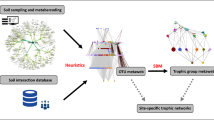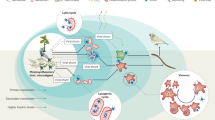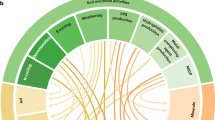Abstract
Soil food webs are critical for maintaining ecosystem functions but are challenged by various stressors including climate change, habitat destruction and pollution. Although complex multitrophic networks can, in theory, buffer environmental stress, the effects of anthropogenic chemicals on soil food webs under climate change remain poorly understood. Here we propose that the effects of chemical pollution on soil communities have been largely underestimated, particularly for climate change-affected ecosystems. We explore the interactive effects of environmental stressors on soil food webs and the importance of integrating chemical pollution impacts into assessing soil food web stability. We also discuss a conceptual framework involving microbiome manipulation, community compensatory dynamics and interaction modulation to mitigate the combined effects of chemical pollution and climate change on soil food webs.
This is a preview of subscription content, access via your institution
Access options
Access Nature and 54 other Nature Portfolio journals
Get Nature+, our best-value online-access subscription
27,99 € / 30 days
cancel any time
Subscribe to this journal
Receive 12 digital issues and online access to articles
118,99 € per year
only 9,92 € per issue
Buy this article
- Purchase on SpringerLink
- Instant access to full article PDF
Prices may be subject to local taxes which are calculated during checkout



Similar content being viewed by others
References
Petters, S. et al. The soil microbial food web revisited: predatory myxobacteria as keystone taxa? ISME J. 15, 2665–2675 (2021).
Scheu, S. The soil food web: structure and perspectives. Eur. J. Soil Biol. 38, 11–20 (2002).
Sigmund, G. et al. Addressing chemical pollution in biodiversity research. Glob. Change Biol. 29, 3240–3255 (2023).
Thakur, M. P. et al. Towards an integrative understanding of soil biodiversity. Biol. Rev. 95, 350–364 (2020).
van der Putten, W. H. et al. Soil biodiversity needs policy without borders. Science 379, 32–34 (2023).
Groh, K., Vom Berg, C., Schirmer, K. & Tlili, A. Anthropogenic chemicals as underestimated drivers of biodiversity loss: scientific and societal implications. Environ. Sci. Technol. 56, 707–710 (2022).
Sylvester, F. et al. Better integration of chemical pollution research will further our understanding of biodiversity loss. Nat. Ecol. Evol. 7, 1552–1555 (2023).
International Network on Soil Pollution (INSOP). fao.org https://www.fao.org/global-soil-partnership/global-soil-partnershipinsopen/en/ (2022).
Wang, F. et al. Emerging contaminants: a one health perspective. Innovation 5, 100612 (2024).
Wang, Z., Walker, G. W., Muir, D. C. & Nagatani-Yoshida, K. Toward a global understanding of chemical pollution: a first comprehensive analysis of national and regional chemical inventories. Environ. Sci. Technol. 54, 2575–2584 (2020).
Bernhardt, E. S., Rosi, E. J. & Gessner, M. O. Synthetic chemicals as agents of global change. Front. Ecol. Environ. 15, 84–90 (2017).
Liu, Y.-R. et al. Soil contamination in nearby natural areas mirrors that in urban greenspaces worldwide. Nat. Commun. 14, 1706 (2023).
UNEP Global Assessment of Soil Pollution: Summary for Policymakers (FAO, 2021).
Zero pollution action plan. European Commission https://environment.ec.europa.eu/strategy/zero-pollution-action-plan_en (2021).
EU Biodiversity Strategy for 2030–Bringing Nature Back Into Our Lives (Publications Office of the European Union, 2021).
Li, Y., Wang, X. & Sun, Z. Ecotoxicological effects of petroleum-contaminated soil on the earthworm Eisenia fetida. J. Hazard. Mater. 393, 122384 (2020).
Liu, Y.-R., Delgado-Baquerizo, M., Bi, L., Zhu, J. & He, J.-Z. Consistent responses of soil microbial taxonomic and functional attributes to mercury pollution across China. Microbiome 6, 183 (2018).
Wang, Y., Slotsbo, S., Damgaard, C. F. & Holmstrup, M. Influence of soil moisture on bioaccumulation, growth, and recruitment of Folsomia candida exposed to phenanthrene-polluted soil. Environ. Sci. Technol. 57, 3085–3094 (2023).
Kelly, B. C., Ikonomou, M. G., Blair, J. D., Morin, A. E. & Gobas, F. A. Food web specific biomagnification of persistent organic pollutants. Science 317, 236–239 (2007).
Sánchez-Bayo, F. Impacts of agricultural pesticides on terrestrial ecosystems. Ecol. Impacts Toxic Chem. 2011, 63–87 (2011).
Tison, L., Beaumelle, L., Monceau, K. & Thiéry, D. Transfer and bioaccumulation of pesticides in terrestrial arthropods and food webs: state of knowledge and perspectives for future research. Chemosphere 357, 142036 (2024).
Sánchez-Bayo, F., Ward, R. & Beasley, H. A new technique to measure bird’s dietary exposure to pesticides. Anal. Chim. Acta 399, 173–183 (1999).
Yamamuro, M. et al. Neonicotinoids disrupt aquatic food webs and decrease fishery yields. Science 366, 620–623 (2019).
Roodt, A. P., Huszarik, M., Entling, M. H. & Schulz, R. Aquatic-terrestrial transfer of neonicotinoid insecticides in riparian food webs. J. Hazard. Mater. 455, 131635 (2023).
Douglas, M. R., Rohr, J. R. & Tooker, J. F. EDITOR’S CHOICE: neonicotinoid insecticide travels through a soil food chain, disrupting biological control of non‐target pests and decreasing soya bean yield. J. Appl. Ecol. 52, 250–260 (2015).
Ni, B., Lin, D., Cai, T., Du, S. & Zhu, D. Soil plastisphere reinforces the adverse effect of combined pollutant exposure on the microfood web. Environ. Sci. Technol. 58, 21641–21652 (2024).
Wang, X. et al. Heavy metal contamination collapses trophic interactions in the soil microbial food web via bottom-up regulation. Soil Biol. Biochem. 184, 109058 (2023).
Zhu, D., Ding, J., Wang, Y.-F. & Zhu, Y.-G. Effects of trophic level and land use on the variation of animal antibiotic resistome in the soil food web. Environ. Sci. Technol. 56, 14937–14947 (2022).
Liu, M., Wang, C. & Zhu, B. Drought alleviates the negative effects of microplastics on soil micro-food web complexity and stability. Environ. Sci. Technol. 57, 11206–11217 (2023).
Thakur, M. P. & Geisen, S. Trophic regulations of the soil microbiome. Trends Microbiol. 27, 771–780 (2019).
Wu, C., Chao, Y., Shu, L. & Qiu, R. Interactions between soil protists and pollutants: an unsolved puzzle. J. Hazard. Mater. 429, 128297 (2022).
Du, S. et al. Stronger responses of soil protistan communities to legacy mercury pollution than bacterial and fungal communities in agricultural systems. ISME Commun. 2, 69 (2022).
Soliman, M. M., Hesselberg, T., Mohamed, A. A. & Renault, D. Trophic transfer of heavy metals along a pollution gradient in a terrestrial agro-industrial food web. Geoderma 413, 115748 (2022).
Potts, L. D. et al. Chronic environmental perturbation influences microbial community assembly patterns. Environ. Sci. Technol. 56, 2300–2311 (2022).
Liu, J. et al. Ecological effects of combined pollution associated with e-waste recycling on the composition and diversity of soil microbial communities. Environ. Sci. Technol. 49, 6438–6447 (2015).
Beauchesne, D., Cazelles, K., Archambault, P., Dee, L. E. & Gravel, D. On the sensitivity of food webs to multiple stressors. Ecol. Lett. 24, 2219–2237 (2021).
Rillig, M. C. et al. Increasing the number of stressors reduces soil ecosystem services worldwide. Nat. Clim. Change 13, 478–483 (2023).
Zhu, X. et al. Substantial halogenated organic chemicals stored in permafrost soils on the Tibetan Plateau. Nat. Geosci. 16, 989–996 (2023).
Noyes, P. D. et al. The toxicology of climate change: environmental contaminants in a warming world. Environ. Int. 35, 971–986 (2009).
Peng, Z. et al. Agricultural subsoil microbiomes and functions exhibit lower resistance to global change than topsoils in Chinese agroecosystems. Nat. Food 6, 375–388 (2025).
Zheng, X. et al. Organochlorine contamination enriches virus-encoded metabolism and pesticide degradation associated auxiliary genes in soil microbiomes. ISME J. 16, 1397–1408 (2022).
Jackson, M. C., Pawar, S. & Woodward, G. The temporal dynamics of multiple stressor effects: from individuals to ecosystems. Trends Ecol. Evol. 36, 402–410 (2021).
Merz, E. et al. Disruption of ecological networks in lakes by climate change and nutrient fluctuations. Nat. Clim. Change 13, 389–396 (2023).
Lau, J. A. & Lennon, J. T. Rapid responses of soil microorganisms improve plant fitness in novel environments. Proc. Natl Acad. Sci. USA 109, 14058–14062 (2012).
Valliere, J. M., Wong, W. S., Nevill, P. G., Zhong, H. & Dixon, K. W. Preparing for the worst: utilizing stress‐tolerant soil microbial communities to aid ecological restoration in the Anthropocene. Ecol. Solut. Evid. 1, e12027 (2020).
Andrade‐Linares, D. R., Lehmann, A. & Rillig, M. C. Microbial stress priming: a meta‐analysis. Environ. Microbiol. 18, 1277–1288 (2016).
Hawkes, C. V. & Keitt, T. H. Resilience vs. historical contingency in microbial responses to environmental change. Ecol. Lett. 18, 612–625 (2015).
Arias-Sánchez, F. I., Vessman, B., Haym, A., Alberti, G. & Mitri, S. Artificial selection improves pollutant degradation by bacterial communities. Nat. Commun. 15, 7836 (2024).
Liu, C. et al. Root microbiota confers rice resistance to aluminium toxicity and phosphorus deficiency in acidic soils. Nat. Food 4, 912–924 (2023).
Ruan, Z. et al. Engineering natural microbiomes toward enhanced bioremediation by microbiome modeling. Nat. Commun. 15, 4694 (2024).
Großkopf, T. & Soyer, O. S. Synthetic microbial communities. Curr. Opin. Microbiol. 18, 72–77 (2014).
Jansson, J. K., McClure, R. & Egbert, R. G. Soil microbiome engineering for sustainability in a changing environment. Nat. Biotechnol. 41, 1716–1728 (2023).
Mueller, U. G. & Sachs, J. L. Engineering microbiomes to improve plant and animal health. Trends Microbiol. 23, 606–617 (2015).
Berg, S. et al. Effects of commercial microbial biostimulants on soil and root microbial communities and sugarcane yield. Biol. Fertil. Soils 56, 565–580 (2020).
Wong, W. S. et al. Limited efficacy of a commercial microbial inoculant for improving growth and physiological performance of native plant species. Conserv. Physiol. 12, coae037 (2024).
Connell, S. D. & Ghedini, G. Resisting regime-shifts: the stabilising effect of compensatory processes. Trends Ecol. Evol. 30, 513–515 (2015).
Gonzalez, A. & Loreau, M. The causes and consequences of compensatory dynamics in ecological communities. Annu Rev. Ecol. Evol. Syst. 40, 393–414 (2009).
Hamilton, C. D., Kovacs, K. M., Ims, R. A., Aars, J. & Lydersen, C. An Arctic predator–prey system in flux: climate change impacts on coastal space use by polar bears and ringed seals. J. Anim. Ecol. 86, 1054–1064 (2017).
Myers, R. A. & Worm, B. Rapid worldwide depletion of predatory fish communities. Nature 423, 280–283 (2003).
Sahasrabudhe, S. & Motter, A. E. Rescuing ecosystems from extinction cascades through compensatory perturbations. Nat. Commun. 2, 170 (2011).
Schwarz, B. et al. Warming alters energetic structure and function but not resilience of soil food webs. Nat. Clim. Change 7, 895–900 (2017).
Nielsen, U. N., Wall, D. H. & Six, J. Soil biodiversity and the environment. Annu. Rev. Environ. Resour. 40, 63–90 (2015).
Ives, A. R., Gross, K. & Klug, J. L. Stability and variability in competitive communities. Science 286, 542–544 (1999).
Vasseur, D. A. & Fox, J. W. Environmental fluctuations can stabilize food web dynamics by increasing synchrony. Ecol. Lett. 10, 1066–1074 (2007).
Norberg, J. et al. Phenotypic diversity and ecosystem functioning in changing environments: a theoretical framework. Proc. Natl Acad. Sci. USA 98, 11376–11381 (2001).
Bartley, T. J. et al. Food web rewiring in a changing world. Nat. Ecol. Evol. 3, 345–354 (2019).
Lu, X. et al. Drought rewires the cores of food webs. Nat. Clim. Change 6, 875–878 (2016).
Li, Z. P. et al. Colonization ability and uniformity of resources and environmental factors determine biological homogenization of soil protists in human land-use systems. Glob. Change Biol. 30, e17411 (2024).
Tian, Y. et al. Stover management affects soil food webs and regulates the decomposition pathway in a maize field.Agric. Ecosyst. Environ. 376, 109229 (2024).
Yin, R. et al. Nitrogen deposition stimulates decomposition via changes in the structure and function of litter food webs. Soil Biol. Biochem. 166, 108522 (2022).
Rosenblatt, A. E. & Schmitz, O. J. Climate change, nutrition, and bottom-up and top-down food web processes. Trends Ecol. Evol. 31, 965–975 (2016).
DeAngelis, K. M. Chemical communication connects soil food webs. Soil Biol. Biochem. 102, 48–51 (2016).
Matz, C. & Kjelleberg, S. Off the hook–how bacteria survive protozoan grazing. Trends Microbiol. 13, 302–307 (2005).
DeAngelis, K. M. Rhizosphere microbial communication in soil nutrient acquisition. Mol. Microb. Ecol. Rhizosphere 1, 823–832 (2013).
Hsueh, Y.-P., Mahanti, P., Schroeder, F. C. & Sternberg, P. W. Nematode-trapping fungi eavesdrop on nematode pheromones. Curr. Biol. 23, 83–86 (2013).
de Rooij, M. F. et al. A loss-of-adhesion CRISPR-Cas9 screening platform to identify cell adhesion-regulatory proteins and signaling pathways. Nat. Commun. 13, 2136 (2022).
Sharpee, W. C. & Dean, R. A. Form and function of fungal and oomycete effectors. Fungal Biol. Rev. 30, 62–73 (2016).
Acknowledgements
This research is supported by the National Natural Science Foundation of China (42425701) and the Fundamental Research Funds for the Central Universities (2662025PY010). M.D.-B. acknowledges support from the Spanish Ministry of Science and Innovation for the I+D+i project PID2020-115813RA-I00 funded by MCIN/AEI/10.13039/501100011033. B.K.S.ʼs work on soil communities is supported by Australian Research Council (DP230101448).
Author information
Authors and Affiliations
Contributions
Y.-R.L., S.W. and Y.-G.Z. led the conceptualization and writing of the paper. B.K.S., X.H., Y.-Y.H., M.D.-B., W.T., Q.H., M.C.R. and Y.-G.Z. revised the paper. S.W., W.Z. and Z.L. illustrated the figures. All authors reviewed the paper and approved the final version of the manuscript.
Corresponding authors
Ethics declarations
Competing interests
The authors declare no competing interests.
Peer review
Peer review information
Nature Ecology & Evolution thanks Mark Tibbett and the other, anonymous, reviewer(s) for their contribution to the peer review of this work.
Rights and permissions
Springer Nature or its licensor (e.g. a society or other partner) holds exclusive rights to this article under a publishing agreement with the author(s) or other rightsholder(s); author self-archiving of the accepted manuscript version of this article is solely governed by the terms of such publishing agreement and applicable law.
About this article
Cite this article
Liu, YR., Wen, S., Singh, B.K. et al. Vulnerability of soil food webs to chemical pollution and climate change. Nat Ecol Evol (2025). https://doi.org/10.1038/s41559-025-02736-1
Received:
Accepted:
Published:
DOI: https://doi.org/10.1038/s41559-025-02736-1



